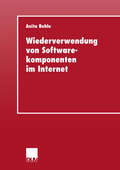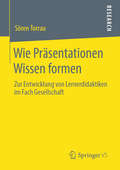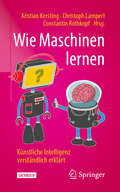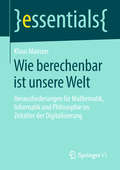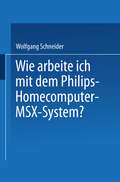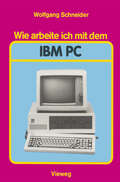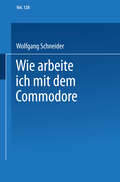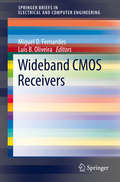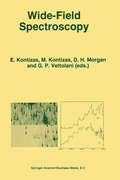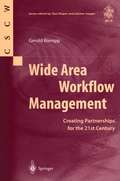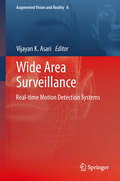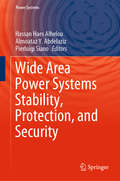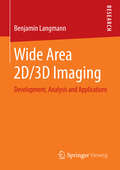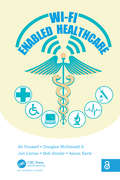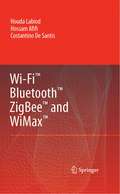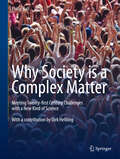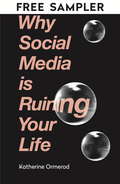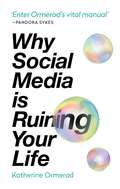- Table View
- List View
Wiederverwendung von Softwarekomponenten im Internet
by Anita BehleAnita Behle diskutiert Ansätze der Softwarewiederverwendung, aktuelle Entwicklungen im Bereich der Komponententechnologien (Java Beans, EJB, ActiveX) und Realisierungsansätze für Web-basierte Informationssysteme.
Wiederverwendung von Software: Framework für betriebliche Informationssysteme (Schriften zur EDV-orientierten Betriebswirtschaft)
by Helge HessWie Schnecken sich in Schale werfen: Muster tropischer Meeresschnecken als dynamische Systeme
by Hans MeinhardtSpannende Einblicke in ein faszinierendes ForschungsgebietSchalenmuster sind ein Bilderbuch der Natur. Sie helfen bei der Untersuchung dynamischer Systeme und biologischer Musterbildung, denn Schnecken zeichnen jeden Schritt ihres Schalenbaus auf.Hans Meinhardt hat diese Entstehungsprotokolle entschlüsselt und in verblüffend naturgetreuen Computer-Simulationen nachgezeichnet.Am Beispiel der Muster auf den Schalen tropischer Meeresschnecken zeigt er die Gesetzmäßigkeiten auf, nach denen sich die Strukturbildung vollzieht.Das großformatige Buch überzeugt durch Fachkompetenz und Ästhetik. Es bietet Ihneno verständliche Einblicke in erstaunliche wissenschaftliche Erkenntnisseo großartige Farbaufnahmen der Original-Schalen und Computer-Modelleo aussagekräftige Computer-Simulationen und Graphikeno ausführliche Kommentare und Gleichungeno DOS-Diskette für Ihre eigenen ExperimenteSichern Sie sich dieses anregende Natur-Lehrbuch, das wissenschaftlich interessierte Fachleser ebenso begeistern wird wie kreative Computer-Anwender.Fachkommentare zur englischen Ausgabe:"Hans Meinhardt hat die bemerkenswerte Leistung vollbracht, ein Buch zu schreiben, das als Bildband wertvoll ist und dennoch eine Fülle von partiellen Differentialgleichungen bietet. Es beinhaltet eine gute Einführung in das Gebiet der dynamischen Systeme und ist obendrein noch lesbar und wunderschön." (Nature)"Das Buch bietet sich an als wunderbares Geschenk sowohl für jeden, der daran interessiert ist, wie ein mathematisches Modell entworfen und realisiert wird, als auch für den, der sich für den Gegenstand selbst begeistert." (Science)
Wie Präsentationen Wissen formen: Zur Entwicklung von Lernerdidaktiken im Fach Gesellschaft
by Sören TorrauSören Torrau analysiert in seiner Studie einen Wandel der Unterrichtskultur im Fach Gesellschaft, wobei die Schülerpräsentation als digitales Format eine tragende Rolle spielt. Dazu zentriert der Autor die didaktische Operation des Zeigens, die Schüler*innen phasenweise übertragen wird. Historische Fallbeispiele und drei empirische Fallstudien zu den Themen Novemberpogrome, Rassismus und Sozialismus verdeutlichen, wie Schüler*innen in Präsentationen Wissen herstellen. Es gelingt nachzuweisen, dass Schüler*innen durch Präsentationen lernen können, wie sich Wissen öffentlich in sozialer Aufeinander-Bezogenheit konstituiert, da sie selbst in anderer Rolle – als Zeigende – handeln. Im Ergebnis können Lernerdidaktiken rekonstruiert, curriculare Entwicklungsprozesse zur Autorisierung offiziellen Wissens nachgezeichnet und Grundrisse einer Soziologiedidaktik entwickelt werden.
Wie Maschinen lernen: Künstliche Intelligenz verständlich erklärt
by Kristian Kersting Christoph Lampert Constantin RothkopfKünstliche Intelligenz und Maschinelles Lernen: Erweitern Sie Ihr Fachwissen mit diesem Sachbuch Was verbirgt sich überhaupt hinter Künstlicher Intelligenz (KI) und Maschinellem Lernen (ML)? Dieses Sachbuch liefert verständliche Antworten. ML und KI spielen im Zuge von Industrie 4.0 und der Digitalisierung eine immer größere Rolle. Ganz ohne komplexe mathematische Formeln bringt Ihnen dieses Sachbuch die grundlegenden Methoden, Anwendungen und Vorgehensweisen des Maschinellen Lernens und der Künstlichen Intelligenz näher. Lisa, die Protagonistin in diesem Buch, illustriert alle Themen anhand von Alltagssituationen. Dadurch erschließt sich Ihnen das Fachwissen, das bisher nur Experten vorbehalten war, einfach und leicht verständlich. Mit diesem Buch eignen Sie sich im Handumdrehen neues Wissen an, mit dem Sie innerhalb der Diskussion um Chancen und Risiken aktueller Entwicklungen garantiert punkten können. Eine Einführung in die Prinzipien von KI und ML Dieses Sachbuch setzt zunächst bei den Grundlagen der Künstlichen Intelligenz und des Maschinellen Lernens an. Hier werden u. a. folgende Fragen geklärt:Was sind Daten?Was sind Algorithmen?Was ist mit Regression gemeint?Wozu dienen Clusteranalysen?Schwerpunktmäßig beschäftigt sich dieses Werk mit Bedeutung und Funktionsweise wichtiger Algorithmen des Maschinellen Lernens. Aufgeteilt in einzelne Kapitel, tauchen Sie so mit Hilfe vieler Abbildungen Schritt für Schritt tiefer in die Materie ein. Zudem bringen Ihnen die Autoren u. a. folgende Verfahren und Aspekte näher:k-MeansEntscheidungsbäumeVerzerrung-Varianz-DilemmaBig DataNeuronale NetzeDie gesamtgesellschaftliche Bedeutung im BlickDaneben verliert dieses Sachbuch auch die gesellschaftliche Bedeutung von Künstlicher Intelligenz und Maschinellem Lernen nicht aus dem Blick. Lesen Sie mehr über Fragestellungen der Sicherheit und Ethik im Zusammenhang mit Künstlicher Intelligenz. All das macht dieses Werk zu einer Leseempfehlung für:Themeninteressierte, die verstehen möchten, was sich hinter den Schlagworten KI und ML verbirgt Entscheidungsträger aus Politik und WirtschaftSchülerinnen und Schüler, welche die Zukunft mitgestalten wollen
Wie halten Sie Ihre Gabel?: Von mentaler Programmierung zu innerer Freiheit
by Gundolf R. WendeWer mentale Programmierungen erkennt und bei sich ändert, wird innerlich souverän und kann frei und selbst bestimmt gestalten. In der Regel ist uns nicht bewusst, dass sich bereits in frühester Kindheit und Jugend die Art und Weise unseres Denkens und Handelns manifestiert. Daran ändert sich meist während unseres ganzen Lebens recht wenig. Doch was, wenn Wirtschaft, Gesellschaft und Arbeitswelt sich jetzt so schnell und radikal wandeln wie nie zuvor – während wir unbewusst bei alten Programmierungen bleiben? Wir werden innerlich unsicher, agieren zaghaft und unsouverän. Es mangelt uns an mentaler Flexibilität und psychologischer Sicherheit, um den Wandel zu gestalten. Wir sind häufig im Widerstand und klammern uns an Hergebrachtes, ohne wirklich zu begreifen, warum. Wir verstehen die Programme dahinter nicht.Das Buch richtet sich an ein breites Publikum. Es spricht all diejenigen an, die das Gefühl haben, „festzustecken“ und die freier und selbst bestimmter leben möchten. Leistungsorientierte Menschen in verantwortungsvollen Positionen in Wirtschaft, Politik, Wissenschaft, Kultur etc., suchen in einer brüchigen, nicht-linearen Welt einen inneren Anker, um mutig und inspiriert Neues gestalten zu können.
Wie berechenbar ist unsere Welt: Herausforderungen für Mathematik, Informatik und Philosophie im Zeitalter der Digitalisierung (essentials)
by Klaus MainzerKlaus Mainzer legt in diesem essential dar, dass die Zukunft von KI und Digitalisierung eine nüchterne Analyse erfordert, die Grundlagenforschung mit Anwendung verbindet. Berechenbarkeits- und Beweistheorie können dazu beitragen, Big Data und Machine Learning sicherer zu bewältigen. Dabei zeigt sich, dass die komplexen Herausforderungen der digitalen und analogen Welt in Grundlagenfragen der Mathematik, Informatik und Philosophie tief verwurzelt sind.
Wie arbeite ich mit dem Commodore 128
by Wolfgang SchneiderDas Buch Wie arbeite ich mit dem Commodore Homecomputer C 728 richtet sich an diejenigen Benutzer eines Commodore Homecomputers, die geringe oder keine Erfah rungen mit Mikrocomputern besitzen, aber auch an diejenigen Benutzer, die möglichst schnell und mühelos an die Bedienung des Commodore Homecomputers mit seinen wichtigsten Zusatzgeräten, wie Bildschirm, Drucker und Diskettenlaufwerke, herangeführt werden möchten, ohne sich durch eine Vielzahl von Bedienungshandbüchern durchlesen zu müssen. Die vom Hersteller mitgelieferten Bedienungshandbücher haben für den genannten Benut zerkreis den Nachteil, daß in ihnen alle Möglichkeiten aufgezeigt werden müssen, die das Mikrocomputersystem bietet. Dieser Vielfalt steht der Anfänger meist hilflos gegenüber. Bedienungshandbücher können i. a. auch nur kurz auf Einzelheiten eingehen, da sonst bei der Beschreibung aller Möglichkeiten der Umfang des Handbuches zu stark anwachsen würde. Außerdem werden in den Bedienungshandbüchern in der Regel Grundkenntnisse der Datenverarbeitung vorausgesetzt, denn man bedient sich bei den Beschreibungen der in der Datenverarbeitung üblichen Fachsprache. Dieses Buch soll die Nachteile, die Bedienungshandbücher für den Anfänger aufweisen, überbrücken helfen, indem sich hier auf das Wesentliche konzentriert wird, dieses dafür aber um so ausführlicher behandelt wird. Zunächst wird in einer kurzen Einleitung der Aufbau von Datenverarbeitungsanlagen erläutert. Dabei erlernt der Leser die wichtigsten Begriffe der Datenverarbeitung. An schließend wird dieses Wissen auf den Commodore Homecomputer umgesetzt. Mit diesem Wissen ausgestattet, wird dem Leser gezeigt, wie das Commodore Home computer-System zu installieren ist und wie es anschließend getestet werden kann.
Wideband, Multiband, and Smart Antenna Systems (Signals and Communication Technology)
by Mohammad Abdul MatinThis book provides current R&D trends and novel approaches in design and analysis of broadband, multiband, and smart antennas for 5G and B5G mobile and wireless applications, as well as the identification of integration techniques of these antennas in a diverse range of devices. The book presents theoretical and experimental approaches to help the reader in understanding the unique design issues and more advanced research. Moreover, the book includes chapters on the fundamentals of antenna theory. The book is pertinent to professionals and researchers working in the field of antenna engineering; it is written for graduate students, researchers, academics, and industry practitioners who want to improve their understanding in the current research trends in design analysis of broadband, multiband, and smart antennas for wireless applications.
Wideband CMOS Receivers (SpringerBriefs in Electrical and Computer Engineering)
by Miguel D. Fernandes Luis B. OliveiraThis book demonstrates how to design a wideband receiver operating in current mode, in which the noise and non-linearity are reduced, implemented in a low cost single chip, using standard CMOS technology. The authors present a solution to remove the transimpedance amplifier (TIA) block and connect directly the mixer’s output to a passive second-order continuous-time Σ∆ analog to digital converter (ADC), which operates in current-mode. These techniques enable the reduction of area, power consumption, and cost in modern CMOS receivers.
Wide-Field Spectroscopy: Proceedings of the 2nd Conference of the Working Group of IAU Commission 9 on “Wide-Field Imaging” held in Athens, Greece, May 20–25, 1996 (Astrophysics and Space Science Library #212)
by E. Kontizas M. Kontizas D. H. Morgan G. P. VettolaniE. KONTIZAS Astronomical Institute National Observatory of Athens P. O. Box 20048 Athens GR-1181O GREECE The international conference on "Wide-Field Spectroscopy" and its sub ject matter were agreed during the general assembly of the International Astronomical Union (IAU) in August 1994 by the Working Group of Com mision 9 "Wi de-Field Imaging". This meeting gave an opportunity to world experts on this subject to gather in Athens, in order to discuss the cur rent exploitation and the impending opportunities that exist in the area of multi-object spectroscopy, with particular emphasis on: 1. Astronomical instruments, data acquisition, processing and analysis techniques. 2. Astrophysical problems best tackled through wide-field, multi-object spectroscopy. The new fibre optic technology offers an important tool for the advancement of basic research and the development of industrial applications. Astronom ical spectroscopy is a field of astronomy which has contributed much to the advancement of fundamental physics. The spectra of hot stars have been used to determine the well-known Balmer formula for the wavelength of hydrogen lines, in the late 19th century. Since then, spectroscopy has made enormous progress in stellar atmosphere studies, in kinematics, and in the detection of high redshifts in the Universe. The traditional techniques of obtaining wide-field spectroscopic data are based on slitless spectroscopy (objective prism). Several observations, world wide, make use ofthese tech niques in order to obtain information on the spectral properties of objects in large areas of the sky.
Wide Area Workflow Management: Creating Partnerships for the 21st Century (Computer Supported Cooperative Work)
by Gerold RiemppIn this volume Gerold Riempp examines the interaction of different workflow management systems (WFMS) in geographically-distributed and legally-separate organisations. This is an emerging field of research known as Wide Area Workflow Management (WAWM). He examines the technical and managerial aspects of workflow management via a framework which he has developed to describe the problems involved in WAWM and to find viable solutions. Based on this theoretical framework, the author also develops a prototype software framework - the Wide Area GroupFlow System - to demonstrate the solutions via practical software tools. The tools will be available to the reader via the WWW. Also included are the results of case studies from some of the 15 developers who have been using this software over the past two years.
Wide Area Surveillance: Real-time Motion Detection Systems (Augmented Vision and Reality #6)
by Vijayan K. AsariThe book describes a system for visual surveillance using intelligent cameras. The camera uses robust techniques for detecting and tracking moving objects. The real time capture of the objects is then stored in the database. The tracking data stored in the database is analysed to study the camera view, detect and track objects, and study object behavior. These set of models provide a robust framework for coordinating the tracking of objects between overlapping and non-overlapping cameras, and recording the activity of objects detected by the system.
Wide Area Power Systems Stability, Protection, and Security (Power Systems)
by Hassan Haes Alhelou Almoataz Y. Abdelaziz Pierluigi SianoThis book proposes new control and protection schemes to improve the overall stability and security of future wide-area power systems. It focuses on the high penetration levels of renewable energy sources and distributed generation, particularly with the trend towards smart grids.The control methods discussed can improve the overall stability in normal and abnormal operation conditions, while the protection methods presented can be used to ensure the secure operation of systems under most severe contingencies.Presenting stability, security, and protection methods for power systems in one concise volume, this book takes the reader on a journey from concepts and fundamentals to the latest and future trends in each topic covered, making it an informative and intriguing read for researchers, graduate students, and practitioners alike.
Wide Area Network (tactile)
by RnibThis diagram shows a wide area network. In the centre of the diagram there are 5 nodes connected together. The is a computer connected to a node on the left, and a computer connected to a node on the right.
Wide Area 2D/3D Imaging: Development, Analysis and Applications
by Benjamin LangmannImaging technology is an important research area and it is widely utilized in a growing number of disciplines ranging from gaming, robotics and automation to medicine. In the last decade 3D imaging became popular mainly driven by the introduction of novel 3D cameras and measuring devices. These cameras are usually limited to indoor scenes with relatively low distances. Benjamin Langmann introduces medium and long-range 2D/3D cameras to overcome these limitations. He reports measurement results for these devices and studies their characteristic behavior. In order to facilitate the application of these cameras, common algorithms are adapted to the 2D/3D data and new approaches for standard computer vision tasks are introduced.
Wi-Fi Home Networking Just the Steps For Dummies
by Keith UnderdahlWi-Fi Home Networking Just the Steps For Dummies is the way to go if you’re ready to go wireless and install your own wireless home network. The book’s easy-to-navigate design features two columns, with numbered step-by-step instructions on one side and corresponding illustrations, screen shots, or photos on the other. There’s no fluff, just the vital stuff—Just The Steps you need to get up to speed fast. This guide covers common networking tasks, including: Setting up wireless access points and configuring your network Adding wireless devices to your network Activating Wi-Fi Security, managing firewalls, and preventing unauthorized network users You don’t have to leave WI-Fi behind when you leave home; this practical reference tells you how to find public hotspots where you can use your Wi-Fi-equipped portable computer and how to network wirelessly with your pocket PC. It covers practical applications like creating a network bridge or adding wireless network storage, plus fun ways to use your tech toys to integrate and enhance your digital life, such as: Setting up a wireless media center so you can use a computer for streaming media, as a TV tuner, as a digital video recorder, or to integrate with your TV and home entertainment system Turning your pocket PC into a remote control Adding a wireless camera to your network Even if your current system with its cables, wires, and convoluted connections works, it’s time to cut the cord. Going wireless gives you many advantages and new options. So take the first step—get this book.
Wi-Fi Enabled Healthcare
by Ali Youssef Douglas McDonald II Jon Linton Bob Zemke Aaron EarleFocusing on its recent proliferation in hospital systems, Wi-Fi Enabled Healthcare explains how Wi-Fi is transforming clinical work flows and infusing new life into the types of mobile devices being implemented in hospitals. Drawing on first-hand experiences from one of the largest healthcare systems in the United States, it covers the key areas as
Wi-Fi Enabled Healthcare
by Ali Youssef Douglas McDonald II Jon Linton Bob Zemke Aaron EarleFocusing on the recent proliferation of Wi-Fi in hospital systems, this book explains how Wi-Fi is transforming clinical work flows and infusing new life into the types of mobile devices being implemented in hospitals. Drawing on years of consulting with hospitals in the US and abroad, and with first-hand experiences from one of the largest healthcare systems in the United States, it covers the key areas associated with wireless network design, security, and support. Reporting on cutting-edge developments and emerging standards in Wi-Fi technologies, the book explores security implications for each device type. It covers real-time location services and emerging trends in cloud-based wireless architecture.
Wi-Fi™, Bluetooth™, Zigbee™ and WiMax™
by Houda Labiod Hossam Afifi Costantino de SantisThe book provides a complete and detailed description of the recent wireless technologies including Wi-Fi, Bluetooth, ZigBee and WiMAX. These technologies are considered to be important topics in the telecommunication industry in the next decade. Some critical subjects are particularly developed such as security, quality of service, roaming and power conservation. The book also includes some chapters on practical aspects.
Why Society is a Complex Matter: Meeting Twenty-first Century Challenges with a New Kind of Science
by Philip BallSociety is complicated. But this book argues that this does not place it beyond the reach of a science that can help to explain and perhaps even to predict social behaviour. As a system made up of many interacting agents – people, groups, institutions and governments, as well as physical and technological structures such as roads and computer networks – society can be regarded as a complex system. In recent years, scientists have made great progress in understanding how such complex systems operate, ranging from animal populations to earthquakes and weather. These systems show behaviours that cannot be predicted or intuited by focusing on the individual components, but which emerge spontaneously as a consequence of their interactions: they are said to be ‘self-organized’. Attempts to direct or manage such emergent properties generally reveal that ‘top-down’ approaches, which try to dictate a particular outcome, are ineffectual, and that what is needed instead is a ‘bottom-up’ approach that aims to guide self-organization towards desirable states.This book shows how some of these ideas from the science of complexity can be applied to the study and management of social phenomena, including traffic flow, economic markets, opinion formation and the growth and structure of cities. Building on these successes, the book argues that the complex-systems view of the social sciences has now matured sufficiently for it to be possible, desirable and perhaps essential to attempt a grander objective: to integrate these efforts into a unified scheme for studying, understanding and ultimately predicting what happens in the world we have made. Such a scheme would require the mobilization and collaboration of many different research communities, and would allow society and its interactions with the physical environment to be explored through realistic models and large-scale data collection and analysis. It should enable us to find new and effective solutions to major global problems such as conflict, disease, financial instability, environmental despoliation and poverty, while avoiding unintended policy consequences. It could give us the foresight to anticipate and ameliorate crises, and to begin tackling some of the most intractable problems of the twenty-first century.
Why Social Media is Ruining Your Life
by Katherine Ormerod**FREE SAMPLER**'This book is a call to arms from the eye of the storm'- Emma Gannon, author of The Multi Hyphen MethodDo you ever obsess about your body? Do you lie awake at night, fretting about the state of your career? Does everyone else's life seem better than yours? Does it feel as if you'll never be good enough? Get a first glimpse of Why Social Media is Ruining Your Life with this exclusive free sampler, and learn how to tackle head on the pressure cooker of comparison and unreachable levels of perfection that social media has created in our modern world.In this book, Katherine Ormerod meets the experts involved in curating, building and combating the most addictive digital force humankind has ever created. From global influencers - who collectively have over 10 million followers - to clinical psychologists, plastic surgeons and professors, Katherine uncovers how our relationship with social media has rewired our behavioural patterns, destroyed our confidence and shattered our attention spans.Why Social Media is Ruining Your Life is a call to arms that will provide you with the knowledge, tactics and weaponry you need to find a more healthy way to consume social media and reclaim your happiness.
Why Social Media is Ruining Your Life
by Katherine OrmerodDo you ever obsess about your body? Do you lie awake at night, fretting about the state of your career?Does everyone else's life seem better than yours? Does it feel as if you'll never be good enough? Why Social Media is Ruining Your Life tackles head on the pressure cooker of comparison and unreachable levels of perfection that social media has created in our modern world.In this book, Katherine Ormerod meets the experts involved in curating, building and combating the most addictive digital force humankind has ever created. From global influencers - who collectively have over 10 million followers - to clinical psychologists, plastic surgeons and professors, Katherine uncovers how our relationship with social media has rewired our behavioural patterns, destroyed our confidence and shattered our attention spans.Why Social Media is Ruining Your Life is a rallying cry that will provide you with the knowledge, tactics and weaponry you need to find a more healthy way to consume social media and reclaim your happiness.Reviews for Why Social Media is Ruining Your Life:'This book is a call to arms from the eye of the storm'- Emma Gannon, author of The Multi-Hyphen Method'Enter Ormerod's vital manual, which will help you navigate social media and turn it not into a weapon, but a useful tool' - Pandora Sykes
